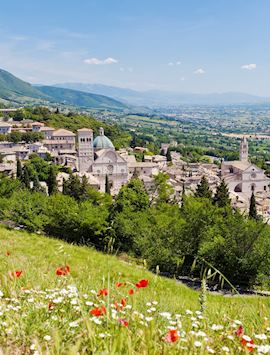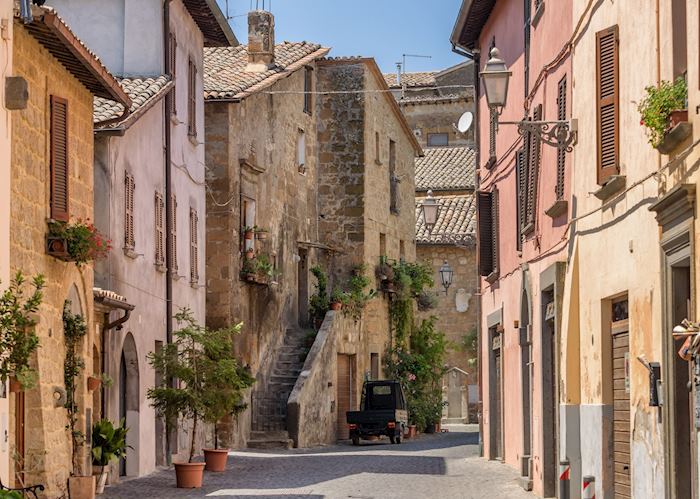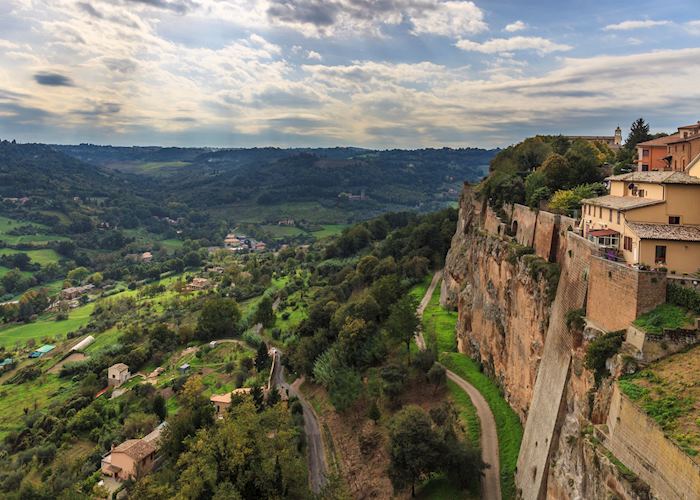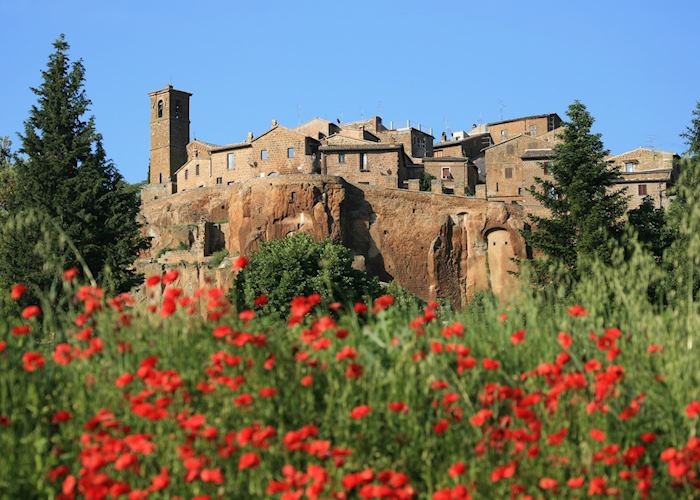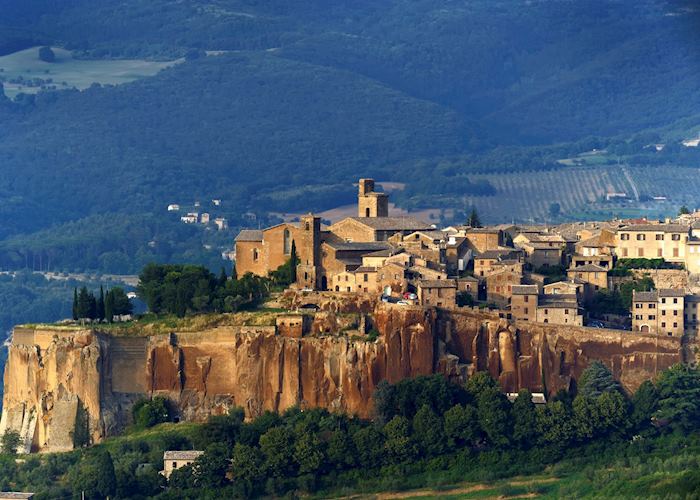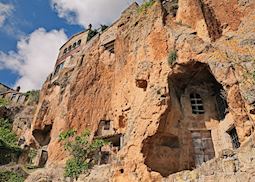Jump to:
Rising from the surrounding rolling countryside like an offering to the gods, Orvieto sits on a massive tufa outcrop, its ocher tones contrasting sharply with the verdant vineyards and olive groves that encircle it. Perched on its elevated position, the town is more or less unchanged since its days as a medieval bastion, its defensive walls topping near-vertical cliffs. Inside the walls, winding lanes and cobbled squares are lined with modest stone houses that give no indication of the proximity of its star attraction, a massive Gothic duomo (cathedral) adorned with intricate frescoes and reliefs that rival those of Florence or Rome.
Begun in 1290 but not completed for another three centuries, Orvieto’s duomo is a huge structure constructed with alternating stripes of travertine and basalt and adorned with a façade of elaborate frescoes, mosaics, reliefs and sculptures. It was commissioned by Pope Urban IV to provide a suitable home for the Corporal of Bolsena. This cloth, which sits below the chalice during mass, dates from a miracle that occurred in nearby Bolsena in 1263 when a visiting priest who doubted the truth of substantiation saw the consecrated communion wafer bleed and stain the corporal.
Enter the cathedral through one of its three bronze doors to see a giant rose window illuminating the internal space — the striped columns and richly ornamented walls only hint of what’s to come. Intricate frescoes adorn the Chapel of the Corporal, which houses the relic. Perhaps most impressive of all is the 15th-century Last Judgement, a vast fresco in the Saint Brizio Chapel by Luca Signorelli, said to have inspired Michelangelo’s work on the Sistine Chapel.
Attached the cathedral is the Papal Palace, once home to the Catholic popes who fled Rome in the mid-13th century and before they moved on to Avignon in 1309. A papal residence until 1550, it’s now a museum detailing the history of the cathedral and the town.
Orvieto was once an important Etruscan capital and the Palazzo dell'Opera del Duomo opposite the cathedral houses a collection of ceramics, tombs and relics from this time. Elsewhere around the town, you’ll come across 11th-century churches, the 13th-century Torre del Moro, which offers sweeping views of the town and the surrounding countryside, and the café-lined Piazza della Repubblica, which was once Orvieto’s Roman forum.
Below the streets, the soft tufa rock has been carved into an elaborate series of tunnels and caves, giving each house and shop an underground storage space. Some of these tunnels are open to the public and you can learn about their varied uses from bomb shelters to wine cellars on an hour-long guided tour.
Best time to visit Orvieto
Orvieto is a year-round destination, its medieval streets as picturesque in winter as in summer. April to June and September to October are the best times to visit however, when the streets are quiet but the weather is warm and dry. In July and August temperatures can reach 84°F (29°C), while in winter they hover just above freezing.
who's been there
-
617-223-4521617-223-4395
- Make an inquiry
Suggested itinerary featuring Orvieto
This sample itinerary will give you an idea of what is possible when you travel in Orvieto, and showcases routes we know work particularly well. Treat this as inspiration, because your trip will be created uniquely by one of our specialists.
Places near Orvieto
- Umbria 26 miles away
- Perugia 31 miles away
- Assisi 36 miles away
- Siena 58 miles away
- Rome 60 miles away
- San Gimignano 75 miles away
- Florence 85 miles away
- Pisa 111 miles away
- Ravenna 118 miles away
- Bologna 130 miles away
- Forte dei Marmi 131 miles away
- Modena 147 miles away
- Porto Venere 148 miles away
- Cinque Terre 154 miles away
- Ischia 167 miles away
- Parma 170 miles away
- Naples 171 miles away
- Costa Smeralda 174 miles away
- Herculaneum 176 miles away
- Portofino and Santa Margherita 183 miles away
- Pompeii 184 miles away
- Capri 186 miles away
- Sorrento 186 miles away
- Venice 189 miles away
- The Amalfi Coast 194 miles away
- Verona 197 miles away
- Genoa 198 miles away
- Sirmione 205 miles away
- Lake Garda 213 miles away
- Gardone Riviera 215 miles away
- Milan 240 miles away
- Sardinia 242 miles away
- Barbaresco 245 miles away
- Alba 246 miles away
- Barolo 247 miles away
- Madonna di Campiglio 251 miles away
- Dolomites 256 miles away
- Como 262 miles away
- Blevio 263 miles away
- Torno 263 miles away
- Laglio 264 miles away
- Lezzeno 266 miles away
- Bellagio 267 miles away
- Alta Badia 268 miles away
- Tremezzo 269 miles away
- Lake Como 270 miles away
- Piedmont 271 miles away
- Matera 272 miles away
- Turin 275 miles away
- Stresa 282 miles away
- Lake Maggiore 284 miles away
- Verbania 284 miles away
- Southern Sardinia 288 miles away
- Puglia 290 miles away
- Alberobello 297 miles away
Photos of Orvieto
Accommodation choices for Orvieto
We've selected a range of accommodation options for when you visit Orvieto. Our choices usually come recommended for their character, facilities and service or location. Our specialists always aim to suggest properties that match your preferences.
-
![Locanda Palazzone, Orvieto]()
Locanda Palazzone
Orvieto
Ideas for experiencing Orvieto
Our specialists seek out authentic ways to get to know the places that could feature in your trip. These activities reflect some of the experiences they've most enjoyed while visiting Orvieto, and which use the best local guides.
-
E-bike from Orvieto to Bagnoregio ![Tufo caves, Orvieto]()
E-bike from Orvieto to Bagnoregio
E-bike from Orvieto to Bagnoregio
Tour the rural roads of Umbria by electric bike, leisurely exploring the rolling countryside and taking in a crumbling medieval village perched on a plug of volcanic rock in a rugged valley followed by lunch at a local farmhouse.
View details


